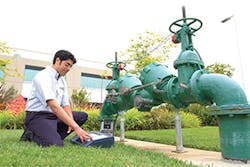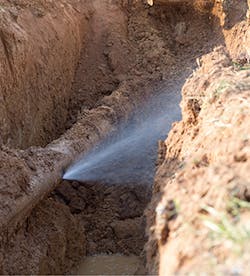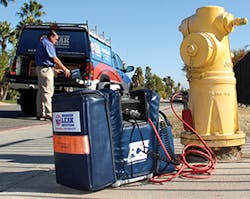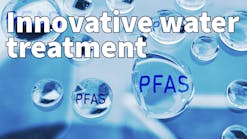Providence Water, the public water utility based in the city of Providence, RI, is no small operation. The utility serves more than 17 cities and towns, providing more than 60% of the state’s drinking water. The utility relies on more than 950 miles of piping to deliver this water.
With so many pipes, leaks happen. Finding and repairing these leaks, though, before they grow into larger and more costly problems, can be a challenge.
To uncover leaks in the past, Providence Water crews would conduct system-wide leak surveys every 10 years. This was far from ideal, with Providence Water discovering only the most obvious leaks. The utility calculated that 11.6% of the water that it pumped into the system’s pipes ended up as non-revenue water. That came out to a yearly loss of more than $954,000.
Then there were the additional costs of undiscovered leaks. Once, a mainline blowout took place under a state road. It cost $45,350 to repair the leak and restore the road.
The evidence made it clear: Providence Water needed a better method to detect leaks. It needed one that would find leaks quickly, lowering the amount of water it lost each year and preventing smaller leaks from growing into larger ones or full-blown blowouts.
The utility, like many others, turned to advanced acoustic leak detection.
A growing number of utilities are making the same choice. That’s because acoustic leak detection—which, as its name suggests, uses sound technology to help municipalities discover leaks that might otherwise elude detection—can save utilities a significant amount of dollars each year.
According to American City & County Magazine, US utility systems lose more than $8 billion every year in what is known as non-revenue-producing water—water that is lost to leaks and not delivered to customers.
Utilities in the US spend about $900 million every year in capital expenses—usually in the form of repairs—related to this non-revenue-producing water, according to American City & County.
Acoustic leak detection can help utilities find leaks quickly. And, it’s a far better alternative than the method that too many utilities still use to find their leaks: walking the system and looking for water that’s risen to the surface.
This, of course, only finds the most obvious leaks. It doesn’t uncover those leaks that are still hidden underground, that cost utilities revenue-producing water, and potentially grow into larger leaks that can result in ruptured streets and major repair jobs.
“Walking the system manually is really the other alternative to acoustic leak detection,” says Jack Merrell, senior marketing manager with Itron. “The utilities I’ve worked with in the past either walk the systems themselves or hire an external company to audit their system every few years. They’ll walk around with a listening device to audit each pipe in their service territory.”
Other utilities do not even schedule regular walk-throughs, Merrell says. Instead, they only audit their systems when they discover physical evidence of a leak.
“A leak will surface and they’ll walk the system,” says Merrell. “It really depends on the utility and the part of the country you are in. But those utilities that aren’t using acoustic testing are usually just walking the system looking for problems. It’s not an ideal way to find leaks.”
Tackling the problem
Providence Water is one of those utilities that wanted a better way to find leaks. It had suffered enough water losses so that officials with the utility were ready to make a change. That change came in 2010, when the utility invested money it had received from the American Recovery and Reinvestment Act into an acoustic leak detection system from manufacturer Itron.
The system included Itron’s MLOG Radio sensors, which are acoustic sensors, and the company’s mlogonline Network Leak Monitoring System. The MLOG sensors provide continuous monitoring of a utility’s distribution system.
Itron’s meters are permanently affixed to the supply side of Providence’s water meters. Because of this setup, Providence Water crews can capture leak detection numbers when they are charting their normal meter reads.
Providence signed on for the deployment of 9,400 MLOG sensors beginning in March 2010. At the same time, the utility began using the mlogonline monitoring software. The vast majority of sensors were in place by May 2012.
Kevin DiNobile, a manager with the water utility, says that the benefits of the leak detection software came quickly. As of June 2012, he says, the utility was tracking 167 possible water leaks. Crews investigated 72 of these potential leaks and drafted 31 work orders for pipe repairs. These first 31 repair jobs, alone, resulted in the recovery of more than 31 million gallons of revenue-producing water every year.
The STAR ZoneScan from Aclara is a good example of how these acoustic monitoring systems work.
According to Aclara, utilities install acoustic loggers at regular intervals throughout their systems. They attach the loggers to valves using the loggers’ magnetic base. Once installed, the loggers monitor and analyze the noise throughout the pipe network to detect leaks.
Utilities can either use the Zone-Scan monitors as a stand-alone system or they can integrate the system with their Advanced Metering Infrastructure—better known as AMI—systems to better analyze the data that the loggers provide.
With the loggers, utilities can track leak information in real time. As Aclara says, this can allow utilities to save on fuel costs. Armed with this real-time leak information, utilities can send out repair crews to targeted areas, depending on where these crews happen to be at any time, reducing the amount of time repair crews spend traveling to a leak site.
Acoustic leak detection saves water and resources.
Once the loggers are installed, operators can monitor the system and analyze data at the utility office. This means that utilities will no longer need to rely on manual or drive-by data collection, again saving on both fuel and labor costs.
In a written statement, Allan Connolly, chief executive officer and president of Aclara, says that he expects more utilities to invest in acoustic leak detection. Utilities today are simply losing too much water, he says.
“In many communities, 10 to 20% of water pumped into distribution systems may be lost due to leaks,” says Connolly. “As infrastructure gets older, the water loss may rise to over 50%. From an environmental perspective, this situation wastes a great deal of water, a precious resource that is becoming more valuable every day.”
Seeking Outside Help
Many municipalities that haven’t yet invested in their own acoustic leak detection systems hire outside consultants at companies such as American Leak Detection. This company operates throughout the US and in Australia and Canada, sending out technicians to walk the water distribution systems of municipalities that are hunting for leaks.
Jimmy Carter, senior director of corporate field services with American Leak Detection, says that more water utilities are either investing in their own acoustic leak detectors or are hiring companies like his to better identify leaks throughout their systems.
“It really depends on the utility,” says Carter. “The size of the utility and the funding available to it make a big difference. We do work with utilities that are thinking about investing in their own leak detection systems, if they receive grant funding that they’ve applied for. But then there are the smaller, rural districts out there. They usually don’t have the manpower or the funding for a leak detection system.”
It still remains that the larger water utilities—especially those in drought-prone areas—are investing in acoustic leak detection, Carter says.
“The larger utilities are trying to be more proactive when it comes to leaks,” says Carter. “They have the funds to invest and they are trying to stay on top of their systems.”
As an example, Carter points to Las Vegas. The Las Vegas Valley Water District, for instance, is earning a reputation for taking the extra steps necessary to reduce water loss. This includes, of course, a heavy investment in leak detection technology.
The Las Vegas Valley Water District is, of course, a big utility. And water is a valuable resource in the area it serves. It makes sense for the water district to invest its dollars in leak detection and water-loss prevention.
Carter says that he expects even more utilities to invest in leak detection technology, whether that means installing their own acoustic leak detection systems or hiring a company, such as American Leak Detection, to find leaks for them.
Lost water is simply too expensive of a problem to ignore, Carter says. At the same time, the EPA is putting more pressure on utilities to reduce the amount of non-revenue-producing water they create.
“Utilities have to pay to get their water out of the well, to treat it with chemicals, and to pump it through their system,” says Carter. “A lot of money goes into distributing water. It all adds up. When that treated water is not being sold to customers, and the utility is paying for it, it is not putting revenue back into the system. That wasted money really adds up when you get into larger percentages of water loss.”
The Hurdles
Why don’t even more utilities follow the lead of Providence Water? If acoustic leak detection helps utilities find and correct leaks more quickly, saving them dollars in the long run, why aren’t all utilities investing in the technology?
Merrell says that many utilities worry that setting up and maintaining a leak detection system will make more work for their employees, especially if acoustic detection uncovers leaks on a daily basis.
“They are concerned that the technology might uncover more leaks than they can get to,” says Merrell. “These systems certainly bring an overall benefit. An acoustic leak detection system will help utilities save money over time. It will help them find leaks that are causing system losses. But many utilities are worried that they don’t have the personnel to address all the leaks that the system finds.”
However, such utilities are approaching acoustic leak detection in the wrong way, Merrell says. The systems can help utility officials not just identify leaks, but identify those leaks that are the largest or the most important.
Utilities can then schedule repairs according to the seriousness of a leak. Maybe there’s a leak just underneath a busy intersection. A utility might want to repair that leak first. Maybe there’s an especially large leak in the system. Again, utility officials can schedule work on that leak first before creating work orders for smaller, lower-priority leaks.
“This way, they have the ability to proactively fix leaks according to their priority,” says Merrell. “This will help utilities make the most of their budgets. The alternative is to fix pipes as leaks show themselves. But knowing where the leaks are, whether they are visible or not, lets utilities prioritize those leaks.”
A technician listens to pinpoint outflow.
Success in North Miami Beach
Karim Rossy, chief engineer with North Miami Beach Water, says that his utility has always taken leak detection seriously. When he began working for the utility, Rossy was the first leak detection official. That was 30 years ago.
Back then, the utility hunted for leaks the old-fashioned way: Utility crewmembers would walk the system armed with SDS correlators searching for sounds that could be a leak. The utility eventually outsourced this work to a consultant.
About two years ago, though, the utility made a change. North Miami Beach Water, in the summer of 2014, began to install acoustic sensors manufactured by Itron. In January of this year, the utility installed the last batch of these sensors.
“We had always been in the forefront of leak detection,” says Rossy. “We’ve always understood just how important leak detection is. Moving to acoustic monitoring was just the next step for our utility.”
Today, 11,000 sensors monitor the North Miami Beach water system. At the same time that the utility made the move to acoustic leak detection, it also embarked on a modernization project that included replacing the utility’s old water meters.
The utility installed 34,000 new water meters, and decided to install one acoustic leak sensor for every three of these new meters. That led to the 11,000 sensors now spread throughout the system.
Rossy says that the sensors have proven invaluable to the utility. “These leak sensors are giving us ongoing information about the leaks in our neighborhoods,” he says. “The software we use ranks the leaks in order of importance too, which helps us make smart repair choices.”
An outside consultant studies the data provided by the sensors, determining which leaks the utility should target first.
“We really study that information so that we can work as efficiently as possible,” says Rossy. “We’ll focus on the most important leaks first, instead of going blindly from valve-to-valve. We’ve learned quickly how much we can benefit from these sensors.”
Rossy says that the leak detection system is well on the way to paying for itself. He says that since North Miami Beach installed its sensors, the utility has saved more than $50,000 in water and chemical costs alone.
And this doesn’t include any savings the utility is receiving by fixing leaks quickly. It’s not inexpensive to repair ruptured roads, cracked sidewalks, or broken water mains, all of which can happen when a leak grows too large. By using acoustic sensors to identify leaks before more serious problems occur, the utility is undoubtedly saving thousands of additional dollars each year.
“Our utility’s infrastructure is aging,” says Rossy. “Like a lot of utilities with older water lines, we do have to deal with leaks on a regular basis. Getting to those leaks before they become bigger problems is what it’s all about. We have a capital improvement program to help us replace the lines. We can’t fix them all over night. We have to be smart about which lines to go after first. These sensors help us determine how to best do this.”
Have utility workers faced a steep learning curve when it comes to studying the data from the sensors? Not really, Rossy says.
The sensors themselves were easy to install, he says. The devices—no bigger than the palm of a hand—wrap easily around pipes. The sensors then send signals through the water system. Utility officials download the data. They then hunt for leaks. The sensors alert workers only to the general vicinity of the leak, because North Miami Beach only has one sensor every 300 feet. Utility workers, armed with correlators, can then go out into the field and pinpoint exactly where that leak is.
“You go dig, and there’s the leak,” says Rossy. “It’s a very efficient way to handle system problems.”
Prioritizing
Merrell says, utilities that embrace acoustic leak detection do so because they know the technology doesn’t increase their workload. Rather, it makes utilities more efficient when they do have leaks to repair.
Perhaps a system walk-through will uncover a pipe leak that has reached the surface. But sound testing might also find a hidden leak that has yet to break through to the surface. It might seem that the utility should resolve the leak that has surfaced first.
But acoustic testing might tell the utility that the hidden leak is actually larger, and should be addressed immediately.
“Utilities are increasingly thinking about the benefits that acoustic leak detection brings, and less about the worry that it will cause them additional work,” says Merrell. “This technology does not decrease the work that utilities have to do. But it does help them prioritize that work. Understanding this is what will inspire more utilities to move forward with this technology in the future.”
Merrell says that a growing number of utilities are investing in leak detection technology today. They’re doing it not only to reduce their own non-revenue-producing water and to improve their bottom lines, but also because water is becoming an increasingly scarce resource.
Many parts of the country continue to work through drought conditions. Utilities operating here have to do whatever they can to preserve their water supply. Reducing the amount of lost water by repairing leaks quickly is one way to stretch this limited supply.
“The quality and availability of our water supplies is not just a local concern any longer,” says Merrell. “The water supply, as a whole, is getting more national attention. The interest in conserving water is increasing. Even if water supply is not an immediate concern, there is still the cost of treating it and delivering it. The costs are a concern. When it comes to system leaks, the sooner utilities find them and fix them, the less impact they have.”
The Savings
How much of an impact can a system of acoustic leak sensors and monitoring software have on a water utility? That varies.
Merrell says, utilities that are losing a large percentage of their water will see a greater reduction in non-revenue-producing water, than will those that did not have as many leaks before installing a system. Some utilities will see better results simply because they are more committed to studying the data provided by acoustic systems, and acting quickly on the information their systems generate.
“It’s not always easy to predicate how much of a reduction in lost water utilities will enjoy,” says Merrell. “So much of it depends on the health of a utility’s system and what is causing the leaks.”
Other Benefits
Reducing non-revenue-producing water is a key benefit of acoustic leak detection. But it’s not the only one.
As Merrell says, many utilities rely on acoustic leak detection to help maintain the health of their pipes and infrastructure. By finding leaks quickly—and before they grow even larger—utilities can pinpoint those areas of their water-delivery system that need the most attention.
By assigning work crews to the pipes most in need of repair, utilities can preserve the lifespan of their infrastructure.
“That is a benefit that doesn’t always get as much notice as it deserves,” says Merrell. “It is as much about reducing non-revenue water as it is about sustaining the health of the system. Maintaining the system will become more of a factor, I believe, as we move forward. There is more concern overall for our water supply around the country.
“The alternative to acoustics, is to take a snapshot in time of a system every year. Monitoring it every single day, which we do with acoustics, is a better solution. That way you can keep your finger on the pulse of your system and maintain its health or improve it in a much more timely manner.”






